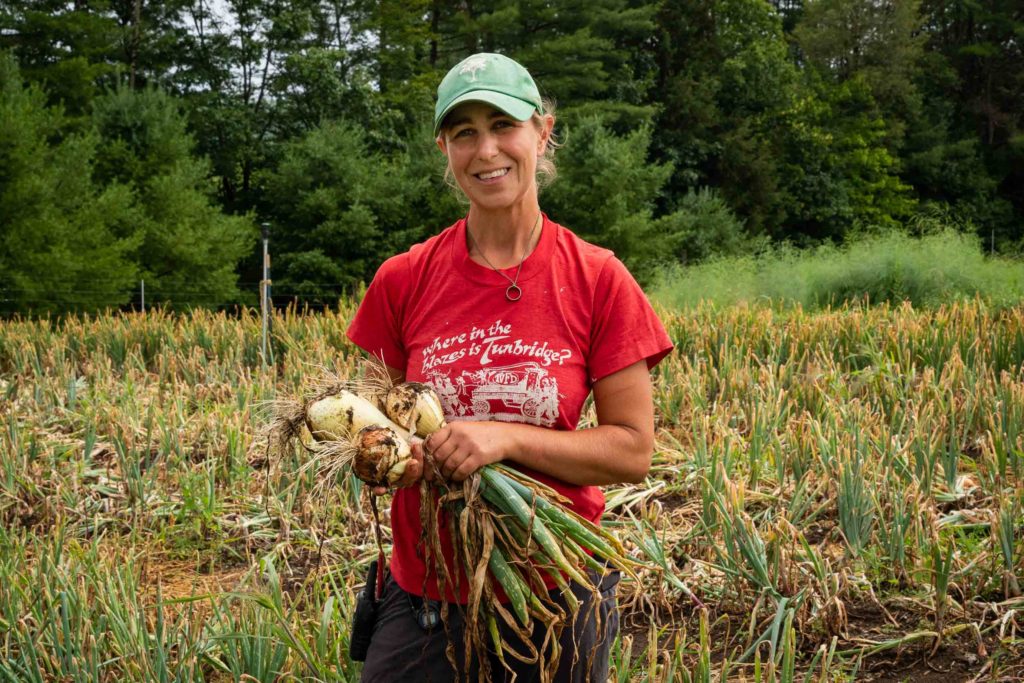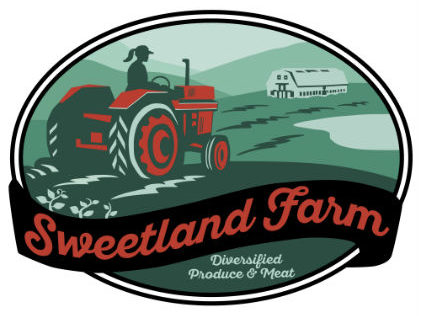We’re pleased to have some time to write about something really important to us. At Sweetland we recently committed to seriously getting our act together on climate change.
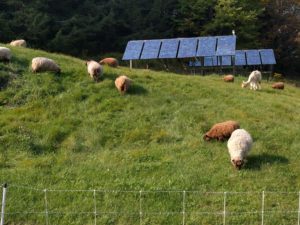
We’ve vaguely been working on this goal for years – you know swapping to LED light bulbs, sealing air gaps, a few solar panels. But for the first 8 seasons, building the farm into a sustainable business – where sustainable has more of a financial meaning – has occupied the front of our minds. This year we got serious and made a real climate action plan and along with it a pledge: We are pledging to reduce the farm’s fossil carbon emissions by 90% in 10 years.
Yup. 90 in 10. Starting from a 2018 baseline, when we’d already done some cutting. It’s ambitious. Ludicrous even. More ambitious than any other goal we’ve heard any local company or municipality commit to.
But plenty of people told us 8 years ago that starting a new farm was somewhere between ambitious and ludicrous too! And this rate of reduction is just what needs to be done. Factoring in our carbon-sensitive forest- and soil-management practices, the farm will be carbon-negative by 2022 and will sequester about 100 tons of carbon per year by 2028.
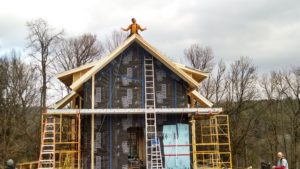
We honestly aren’t sure if we can meet our pledge. It’s gonna be hard work and might cost some money. But, when we started scratching our heads about what we needed to do to erase fossil carbon from the farm, things actually started to seem pretty doable. In 8 years since we took over the farm, we’ve remodeled and/or refurbished every building on the property. Why not remake all of our energy systems in the next 10 years?
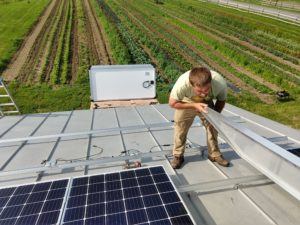
We think we can do it. Read on if you are interested in all the nitty gritty details of our plan for achieving our pledge. The plan will likely evolve as we evaluate costs and feasibility, and as new products become available, but the 90 in 10 pledge is a commitment we expect to be held to. We hope you’ll continue to support us as we make good on this pledge. Also, challenge other businesses you patronize to do the same! Tell them to get serious. Ask them to make and publicize a plan to achieve their 90 in 10 commitment!
Cheers, Sweetland Farm
The Nitty Gritty Details; Sweetland Farm’s 90 in 10 plan
In 2018 (our baseline year) the farm already had a solar thermal system for our domestic hot water, got more than half its heat from wood, super-insulated the farm crew housing, and had about 10.7 kW of solar PV panels operating. Still, we used:
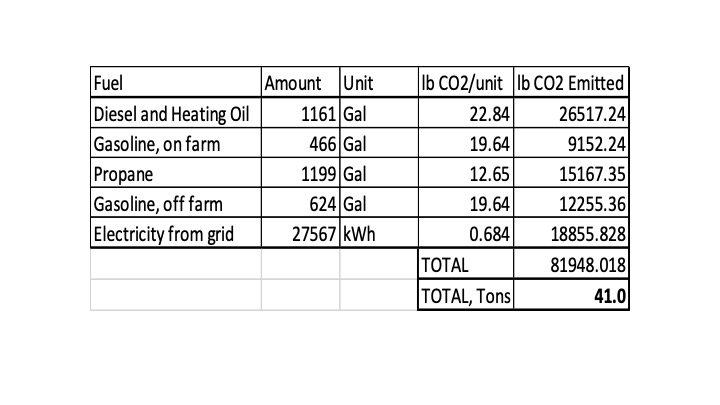
This resulted in a net emissions of 41 tons of CO2 based on the energy mix supplying the New England Grid in 2017 and carbon contained in these fuels. Our pledge is to eliminate 90% of these emissions in 10 years.
The outline of the plan is simple.
- Increase efficiency.
- Replace fossil fuel burning equipment with electric equipment.
- Install more PV panels on existing roof tops to generate the electricity cleanly.
- Buy liquid biofuels for infrequently used equipment not worth replacing.
Specifically here is what we plan to do:
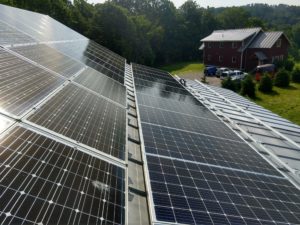
2019: Focus on electricity generation and efficiency. Install 19.4kW of solar PV to make the farm net neutral on electricity draws from the grid. Rooted out old non-LED light bulbs. Even in seldom-used locations. Spray foam air leaks.

2020: We plan to update the walk in cooler with more insulation and greater efficiency. We’ve applied for a grant to do this and hope we get it! Grants and government programs will be key to achieving this rapid transition and we will take advantage of any program we can. We’ll also replace leaky doors and weather strip our farm house.
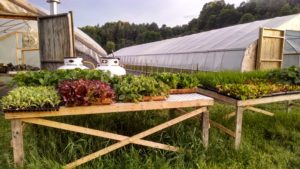
2021: We plan to convert greenhouse space heating from propane to mostly wood. This will enable us to use implement the timber stand improvement practices called for in our forest management plan while utilizing the low-value trees for on-farm heating needs.
2022: We plan to replace remaining fossil burning heaters with air source heat pumps in our farm crew house and our woodshop. The efficiency gain from our walk in cooler project will make the electricity available from our existing PV. We’ll replace the leaky windows in our house too.

2023: We plan to replace our fossil-burning cultivating tractors with electric versions, or convert the existing tractors, installing additional solar panels to meet added electric demand.
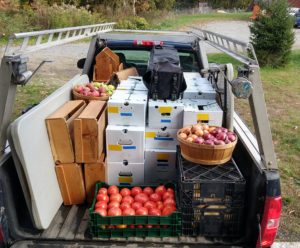
2024: At the end of our current truck’s useful life we plan to replace our delivery truck with an electric vehicle. We sure hope such a device is in reasonable mass production by then! C’mon Elon Musk. You too Toyota. We only need 100 miles of driving range tops! This is possible now!
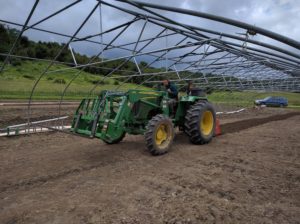
2025: We plan to replace our main tractor, the one that runs our heavy implements, with an electric version. This may require more solar panels and a battery storage solution to enable us to store up power while the tractor is in the field working. We sure hope John Deere will have gotten serious about producing electric farm tractors by this time.
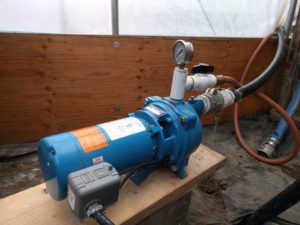
2026: We have a lot of other vehicles and small engines that would not be economical to replace because we use them so infrequently. We plan to switch to biofuels in most remaining liquid fuel combustion engines. We hope a reasonably carbon neutral fuel is widely available by this point – we’ll buy it. Electric irrigation pumps will replace our gas powered pumps and we’ll get an electric lawn mowing tractor.
2027: That wasn’t so hard – we have a whole year extra to make up for stuff we missed and to wander around the farm hunting down the last fossil burning culprits. We’ll probably remember to do something about the old oil heater in the mechanic shop that runs only a few days a year.

2028: Year 10! We are basically done burning fossil carbon. Fossil emissions are a few percent of 2018 values: from propane cookstoves, backup greenhouse heat, and a few small engines that require traditional fuel. It will be time to turn our energy to any remaining embodied carbon in the things we buy.
Note that the first 5 years of the plan are all things that we know how to do and should do immediately. We are almost ashamed to admit the reality that it will take us a few years to get them done. If we had the time and money we could knock off the first 5 year list this spring! Later years of the plan require a few advances in equipment availability. We are really hoping that things like electric delivery trucks and large electric tractors make it into mass production by 2024 or so. But all in all, it’s not that painful of a plan and it’s pretty easy to see how we achieve what seems to be an ‘impossible’ pledge. Maybe now that you’ve looked over our pledge and plan, you can make your own!
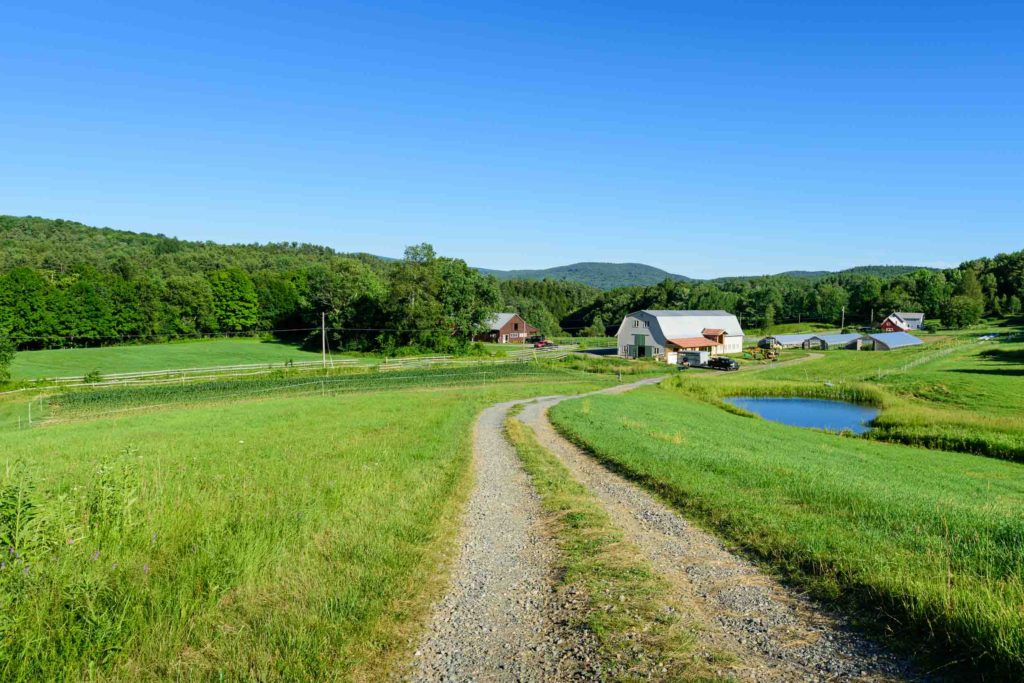
The fine print. Someone is going to ask about details. Good. On carbon projects details matter! Here’s our details.
- How we do our accounting for our pledge: Pick up a Sweetland carrot in 2018. Pick up a Sweetland carrot in 2028. Making the second carrot we’ll have emitted 90% less fossil carbon. About what you expected right? This is how we are doing the math too. There’s a reason we do the math this way. We want to continue to be able to grow the business. We want to continue to replace food in your diet that comes from industrial farms far away with low carbon, high nutrition local food that nourishes you, our landscape, and our Vermont traditions. So we make our commitment for a 90% reduction based on a dollar value of our products, properly adjusted for inflation. If we grow more food, hay, lumber, etc. our emissions allowance will grow. The point is we pledge to reduce the fossil carbon intensity of our activity by 90%. The carrot you eat from our farm in 2028 will emit less than 10% of the carbon than the one you ate in 2018 did. Sure using dollars of farm product value is an imprecise way to do this. Pounds of food could work, too, except we grow hay, cut firewood, raise meat, etc. Honestly, we intend to beat the number by enough to not worry about the details.
- Off farm, indirect, and embodied emissions: We do include our delivery vehicle emissions, which happen off farm but are within our direct control, in our emissions calculations. We also include emissions of our house and our farm crew house. We don’t include our personal vehicle, partly because we don’t track fuel use in it, but we’ll swap that to electric soon too. We know that the whole of the farm’s emissions really also include emissions embodied in the things we buy. For example, the seed supply company also has carbon emissions and so does the FedEx truck delivering packages. Our spending made both of these entities emit more carbon. These indirect emissions are a bit harder to quantify, but likely are 30-50% of our overall emissions. Sorry, they are not part of the 90 in 10 pledge. I know – sounds like a cop out. We are still going to work hard on reducing them though! If we figure out how to handle this better, we may codify it into some more specific pledge in the future. Right now we don’t even really have the tools to calculate the embodied carbon in everything we bought in 2018 to track against. What we will do is reduce our use of products that embody large amounts of carbon emissions, and seek to get our supplies from companies that offer the least emissive alternative. This will create demand signals for our supply companies to take their own emission reduction pledges.
- Non-fossil Carbon – We also burn 8-12 cords of wood per year, and have a brush and waste wood bonfire each year to clean the place up. Combined, these emit something like 15-20 tons of carbon. The brush is usually short rotation – stuff that grew in the last 10 years. We’re willing to call that net-zero since it the sequestration and emission is over a very short time frame. The firewood is from older trees, and has been stored longer so there is a short term release of carbon. Still, in aggregate, our forest has grown substantially in biomass since we have owned the farm and is significantly net-sequestering. We are not promising to maximize forest sequestration right now. One major concern with carbon offsetting programs that we’re watching carefully is that they may cause poor forest management if they prohibit the short term carbon releases too strictly. Short term carbon release is often needed for responsible long term forest stewardship and soundly managed biomass energy is a piece in the climate puzzle. Our forest management case is particularly challenging. Due to heavy cutting before we owned it, our forest is young but also stocked with a lot of poorly formed larger trees. Proper silviculture will have us slowly removing the larger poorly formed trees and thinning the crop of young regrowth that started in the late 1990’s. The strategy can be carbon sensitive, but requires we do make some emissions as we clear out malformed trees to produce valuable long rotation saw timber growth (and ultimately a higher long term carbon sequestration). Along the way to a steady state of maturity, we expect that our 150 acres of young forest will sequester a couple thousand tons more carbon. We may slow the rate of sequestration some in the near term to achieve these longer term goals and meet our biomass energy needs. Similarly, our soils have also increased in organic matter and will continue to do so as we bring in more aggressive cover-cropping rotations, which also conserve nutrients in our soil. Someday we may actually set specific carbon sequestration goals and/or sell our sequestration capacity. For now, we simply pledge to manage our forest and fields in a state of overall net sequestration as much as possible.
- Load Matching: Our plan assumes that as our electric demand grows with reduced reliance on liquid fossil fuels, we can just install more PV panels and net meter our electricity to meet the needs of our increasingly electrified farm. We recognize that as solar provides more and more of our energy on the grid, matching demand to availability will increasingly be an issue for the utility. Luckily the farm’s demand curve (higher in summer and particularly on hot, sunny days when refrigeration needs and tractor power needs are highest) matches well with solar generation. For some activities, however, we will probably have to increasingly consider load dispatching and load matching in later years of our plan. We are aware of the issue but don’t feel much planning can be done right now. We will cross the demand dispatching bridge when the time comes.
That’s all there is to it. We’re ready to start! Are you?!?
